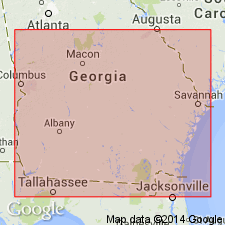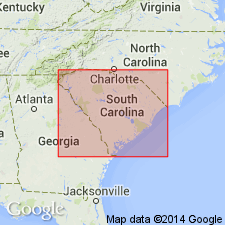
- Usage in publication:
-
- Okefenokee formation
- Modifications:
-
- Named
- Dominant lithology:
-
- Sand
- Gravel
- AAPG geologic province:
-
- South Georgia sedimentary province
Summary:
Okefenokee formation consists in part of coastal-terrace deposits and in part of river-terrace or fluviatile deposits. During this period there was probably a depression of the land, the coast line perhaps being 40 to 75 mi west of its present position. Coastal sands and probably other sediments were laid down, forming a terrace, and contemporary fluviatile deposits were formed on terraces skirting the larger rivers as far as the Fall Line. The coastal terrace formed during this period is a flat plain 20 to 40 mi wide, which varies in elevation from 60 to about 125 ft above sea level. It is covered with gray and white quartz sand. The river terraces lie 50 to 100 ft above zero water level and form prominent topographic features along Savannah, Ocmulgee, and Chattahoochee Rivers. The terrace deposits consist of sands and gravels of fluviatile or fluvio-estuarine origin. The Okefenokee is older and higher than the Satilla formation. It is not in contact with any formation older than Pliocene and Miocene. Thickness is 5 to 40 ft. Included in Columbia group.
Source: GNU records (USGS DDS-6; Reston GNULEX).

- Usage in publication:
-
- Okefenokee formation†
- Modifications:
-
- Abandoned
- AAPG geologic province:
-
- South Georgia sedimentary province
Summary:
†Okefenokee formation of Columbia group. The Pleistocene terrace deposits of the Atlantic Coastal Plain from Delaware to Florida are now [ca. 1938] divided into the 7 formations enumerated under Columbia group (youngest to oldest, Pamlico, Talbot, Penholoway, Wicomico, Sunderland, Coharie and Brandywine), and Satilla and Okefenokee formations have been abandoned.
Source: US geologic names lexicon (USGS Bull. 896, p. 1539, Columbia entry p. 492-493).

- Usage in publication:
-
- Okefenokee Formation
- Modifications:
-
- Areal extent
- Revised
- Age modified
- AAPG geologic province:
-
- Atlantic Coast basin
Summary:
Okefenokee Formation extended to SC and divided into ascending Holly Hill and Eutawville Members. Though the Holly Hill occurs near the base of the formation, lenses may be present at varying altitudes throughout the channel-like bodies. Member includes two lithofacies: a conglomerate and an orthoquartzitic or subarkosic sand, up to 30 ft thick. The overlying Eutawville consists of 20 ft of fine-grained silty, clayey, very poorly sorted sand. Age assigned here is post late Miocene. [In a 1966 publication by the same authors Okefenokee shown as Miocene-Pleistocene(?).]
Source: GNU records (USGS DDS-6; Reston GNULEX).
For more information, please contact Nancy Stamm, Geologic Names Committee Secretary.
Asterisk (*) indicates published by U.S. Geological Survey authors.
"No current usage" (†) implies that a name has been abandoned or has fallen into disuse. Former usage and, if known, replacement name given in parentheses ( ).
Slash (/) indicates name conflicts with nomenclatural guidelines (CSN, 1933; ACSN, 1961, 1970; NACSN, 1983, 2005, 2021). May be explained within brackets ([ ]).

